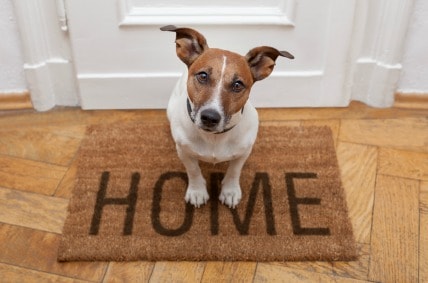How to find your lost dog is a question no one wants to have a need for. Realizing your dog is missing has got to be one of the most heart-stopping moments in dog ownership. Suddenly, all
Steps to Find Your Lost Dog
- First step in finding your lost dog is to gather up recent pictures of your dog. Make quick copies, either on your home printer or at a copy shop.
- Go around your neighborhood, knocking on doors and showing your dog’s pictures to see if anyone has seen him. Leave your contact information in case of future sightings. Leave some copies of your pictures and ask the neighbors to share them with others.
- Post some of the copied pictures on trees and utility poles in your area. Later, after following some of the other steps, go back and place colorful poster board behind the pictures to help draw attention to them.
- Give a copy of the picture to your mail carrier and ask her to keep a lookout. Do the same for UPS and FedEx drivers. These people are all around your area regularly.
- Call your microchip company, if your dog is chipped and ask them to make note that your dog is missing.
- Call the local animal control, humane society, police department, fire department and veterinarian offices to let them know your dog is missing. Often, if someone picks up a lost dog, they will call or take the dog to one of these places. Take your pictures to these places also.
- Visit the animal control and humane society in-person. Mistakes can and do happen. When a dog is brought in or picked up as a stray, the shelter workers will do a “best guess” breed decision on the dog they take in. So, if your dog is a Lab mix and the shelter thinks their new resident is a Pit mix, when you call in you could be mistakenly told that your dog is not there. While there, ask to post a picture of your dog on their bulletin board also.
- Post your dog’s picture and information on Social Media sites. Do this on the lost pet group boards as well as your personal pages. Ask your friends on these pages to share on their pages.
- Organize a search party. Ask all your friends, both on and off social media to come out and scour the area, starting with the neighborhoods around your house and working out to areas further away. Travel by both car and on foot. Call out your dog’s name and also any words familiar to your lost dog, such as “cookie”, “treat” “bye bye” etc. Taking another dog with you can sometimes help as dogs have a very keen sense of smell and the dog could help locate your lost dog.
- Leave some of your familiar smelling clothing, blankets, towels, etc. on your property or in any areas where your lost dog may have been spotted. Often, when a dog is lost, they will gravitate to familiar smells. Check these areas frequently to see if your dog has returned.
- Finally, keep up these steps over and over. Don’t give up. Finding a lost dog takes effort and your dog depends on you to be there for him. There have been many reports of lost dogs being found weeks, months and years later. Following these steps to find your lost dog as quickly as possible after he is missing is your best chance of finding your dog and insuring a happy homecoming.
- To help prevent your dog from becoming lost, check out these tips.https://mostlymutts.com/2018/03/22/prevent-your-dog-from-getting-lost/
